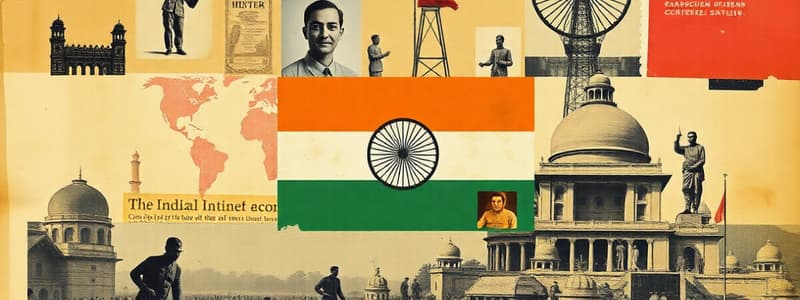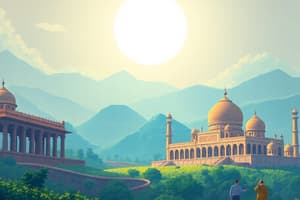Podcast
Questions and Answers
What is one of the key questions that India's five year plans attempt to address?
What is one of the key questions that India's five year plans attempt to address?
- Which countries should India trade with?
- What types of goods should be imported?
- How can technology be used to reduce unemployment?
- How should the goods and services be distributed among people? (correct)
Which factor was considered in the production of goods and services during India's five year plans?
Which factor was considered in the production of goods and services during India's five year plans?
- The number of human laborers versus capital equipment used (correct)
- The influence of foreign markets
- Global warming effects on farming
- Trends in consumer preferences worldwide
What type of economic policies were emphasized in India from 1950-1990?
What type of economic policies were emphasized in India from 1950-1990?
- Privatization of agriculture
- Regulated economic policies (correct)
- Liberalization of trade
- Free market policies
Which of the following topics is NOT associated with the case study approach on agricultural farms?
Which of the following topics is NOT associated with the case study approach on agricultural farms?
What was one of the aims of collecting newspaper cuttings related to global organizations?
What was one of the aims of collecting newspaper cuttings related to global organizations?
Which of the following was a task suggested for students studying agricultural methods?
Which of the following was a task suggested for students studying agricultural methods?
What argument is encouraged to be discussed in relation to agricultural subsidies?
What argument is encouraged to be discussed in relation to agricultural subsidies?
Which of the following refers to the economic changes that occurred in the Indian economy between 1950 and 1990?
Which of the following refers to the economic changes that occurred in the Indian economy between 1950 and 1990?
What are the common goals of India's five year plans?
What are the common goals of India's five year plans?
What was one major drawback of the public sector in the industrial development of India?
What was one major drawback of the public sector in the industrial development of India?
What did the Green Revolution primarily aim to achieve?
What did the Green Revolution primarily aim to achieve?
Why is marketable surplus important for farmers?
Why is marketable surplus important for farmers?
What was a motivation for India to follow self-reliance as a planning objective?
What was a motivation for India to follow self-reliance as a planning objective?
Which of the following describes 'growth with equity' as a planning objective?
Which of the following describes 'growth with equity' as a planning objective?
Why was land reform necessary in India?
Why was land reform necessary in India?
What was the anticipated impact on the agriculture sector due to the Green Revolution?
What was the anticipated impact on the agriculture sector due to the Green Revolution?
Flashcards
India's Five Year Plans
India's Five Year Plans
A series of economic plans aimed at developing the Indian economy in phases.
Goals of Economic Planning
Goals of Economic Planning
Decisions on what, how, and for whom to produce goods and services.
Regulated Economy
Regulated Economy
An economy where the government controls major aspects of economic activity.
Agriculture Development (1950-1990)
Agriculture Development (1950-1990)
Signup and view all the flashcards
Industrial Development (1950-1990)
Industrial Development (1950-1990)
Signup and view all the flashcards
Agricultural Subsidies
Agricultural Subsidies
Signup and view all the flashcards
Occupational Structure
Occupational Structure
Signup and view all the flashcards
Global Economic Organizations
Global Economic Organizations
Signup and view all the flashcards
Mixed Economy Model
Mixed Economy Model
Signup and view all the flashcards
Five Year Plans
Five Year Plans
Signup and view all the flashcards
Green Revolution
Green Revolution
Signup and view all the flashcards
Import Substitution
Import Substitution
Signup and view all the flashcards
Marketable Surplus
Marketable Surplus
Signup and view all the flashcards
Land Reforms
Land Reforms
Signup and view all the flashcards
Self-Reliance
Self-Reliance
Signup and view all the flashcards
Public Sector
Public Sector
Signup and view all the flashcards
Study Notes
Indian Economy 1950-1990
- Studying this chapter will teach learners about India's five-year plans, development policies (agriculture and industry), and the pros and cons of a regulated economy from 1950-1990.
- India achieved freedom in 1947, marking a new era of self-governance.
- The leaders of independent India aimed for an economic system promoting welfare for all citizens rather than a select few.
- Socialism, particularly the model practiced in the Soviet Union, was not the exact model chosen.
- Nehru and other leaders sought an alternative to the extreme versions of capitalism and socialism.
- India aimed for a socialist society with both private and public sectors.
Introduction to Economic Systems
- Every society must answer three essential questions: What goods and services will be produced? How should goods and services be produced? How will goods and services be distributed?
- A market economy (capitalism) relies on supply and demand to answer these questions based on purchasing power.
- In contrast, a socialist economy prioritizes the needs of the population, rather than individual desires.
- Most modern economies are considered mixed economies: combining market forces with government intervention to address societal needs.
What is a Plan?
- A plan outlines resource allocation to meet national goals with specific objectives over a set time period.
- India's plans, originally five-year plans, now also consider twenty-year perspective plans.
- Goals and objectives can conflict, and planners must balance priorities.
- Early Indian plans focused on specific sectors like power generation and irrigation.
The Service Sector's Growth
- A developing country usually sees a decline in agriculture and increase in industry's share of GDP.
- In India, however, the service sector's share grew beyond both agriculture and industry by 1990.
- This shift is a characteristic of a developing nation's structural changes.
Modernization
- Modernization relates not just to technology but to societal changes, especially regarding gender equality.
- New technologies can increase output and efficiency.
- The use of new technologies (e.g., seeds, fertilizers, irrigation) is a key part of modernization.
Self-Reliance
- Self-reliance encourages using domestic resources to reduce dependence on other countries.
- This approach is crucial for economic independence and freedom from external influence.
- However, balancing self-reliance with procuring essential goods internationally is a persistent challenge.
Equity
- Equity in planning means that the benefits of economic growth should reach the poorest members of society.
- Economic policies should aim to reduce inequality among sectors and between various socioeconomic groups.
Land Reforms
- Land reforms were essential for promoting equality.
- Reforms aimed to redistribute land ownership and to improve agricultural productivity, thus giving farmers in India more incentive to work the land.
The Green Revolution
- Marked by the introduction of High Yielding Variety (HYV) seeds (mainly wheat and rice).
- Increased food production for a growing population.
- Improvement of irrigation and other infrastructure to achieve self-sufficiency in food production.
- This also increased the divide between wealthy and less wealthy farmers.
Debates Over Subsidies
- Subsidies played a key role in encouraging farmers to adopt new technologies and production methods.
- They fostered growth and modernization.
- Debates continue over their effectiveness and potential for increasing inequality.
Industrial Policy Resolutions and Trade Policy
- The Industrial Policy Resolution (IPR) of 1956 aimed to govern the direction of India's industrial sector.
- This policy prioritized the public sector and, consequently, focused on domestic production.
- The trade policy was essentially inward looking, promoting domestic industry by minimizing imports.
The Public and Private Sectors
- Balancing the roles of both the public and private sectors is crucial for economic development.
- The public sector is meant to address needs that are not entirely addressed by market forces.
- The private sector drives innovation, growth, and entrepreneurship.
- Finding the optimal balance between these two sectors to promote sustained development and self-reliance is consistently revisited.
Conclusion
- India's economic progress achieved by 1990, with advancements in agriculture, industry, and service sectors.
- Successes and challenges of various plans, policies, and programs are highlighted.
- The need for continuous modernization and adaptation in an evolving global context.
- The importance of reforms to ensure equitable distribution of growth among all segments of society.
Studying That Suits You
Use AI to generate personalized quizzes and flashcards to suit your learning preferences.




